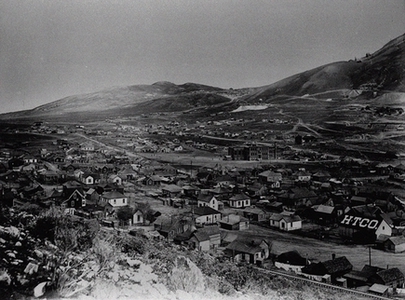EUREKA

Eureka, Utah, c. 1923
Eureka is located approximately seventy miles southwest of Salt Lake City in Juab County. Incorporated as a city in 1892, Eureka became the financial center for the Tintic Mining District, a wealthy gold and silver mining area in Utah and Juab counties. The district was organized in 1869 and by 1899 became one of the top mineral producing areas in Utah. Eureka housed the "Big Four" mines -- Bullion Beck and Champion, Centennial Eureka, Eureka Hill, and Gemini-and later the Chief Consolidated Mining Company. The Chief was developed by the Walter Fitch family, who not only had their own mine in Eureka, but also the company headquarters, family residences, and family cemetery -- a most unique feature in any western mining town.
As with other mining towns, Eureka developed from a camp to a settlement then town. It benefited from competing transportation services of the Union Pacific (1889) and the Denver and Rio Grande Western (1891) railroads. Census statistics indicate the following population figures through 1930, when the impact of the Depression changed its fortunes: 1880 - 122; 1890 - 1,733; 1900 - 3,325; 1910 - 3,829; 1920 - 3,908; 1930 - 3,216. That Eureka's population exhibited ebbs and flows between census years was attributed to the transitory character of a mining town. By the 1980s the population fell below 700.
Eureka's role as the central financial point for the district insured its survival. It housed business establishments, financial institutions, local and county governmental buildings including Eureka City Hall (1899) and a Juab County Courthouse (1892), various churches, and the meeting places for numerous labor, social, and fraternal organizations. Eureka became especially active as a successful political field for Utah's Socialist party. Mining entrepreneurs such as John Q. Packard, John Beck, Jesse Knight, Walter Fitch Sr., and others loomed as important figures in Eureka and Tintic history. A relative calm and peaceful labor environment marked Eureka's past.
The Chief Consolidated operated during the 1930s and into the 1950s, helping to keep Eureka's economy afloat. Small scale mining operations have continued, but most residents work in valley towns and for government services, such as the Tooele Army Depot. Being located on Utah Highway 6, Eureka is on a main trail to the Little Sahara Sand Dunes area. In 1979 Eureka was placed in the National Register of Historic Places as part of the Tintic Mining District Multiple Resource Area, recognizing the importance of remaining buildings and sites.
Disclaimer: Information on this site was converted from a hard cover book published by University of Utah Press in 1994. Any errors should be directed towards the University of Utah Press.